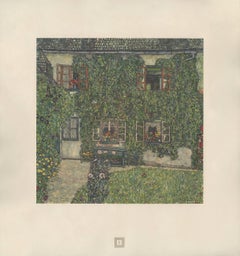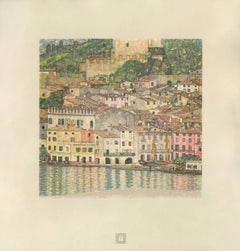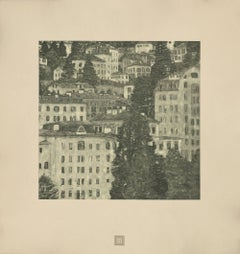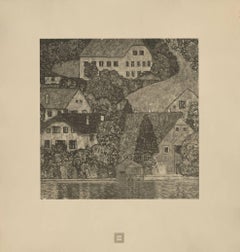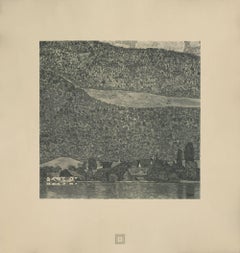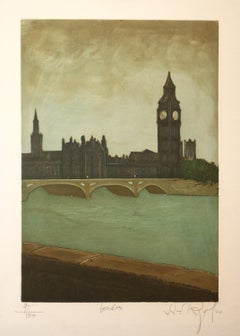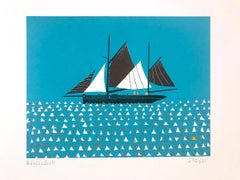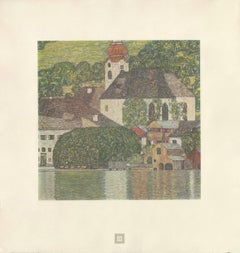(after) Gustav Klimt Landscape Prints
Austrian, 1862-1918
Gustav Klimt was an Austrian symbolist painter and a prominent member of the Vienna Secession movement. Klimt's primary subject was the female body and his works are mostly erotic in nature.to
5
Overall Width
to
Overall Height
to
5
23
180
169
146
131
5
5
3
2
1
1
1
1
1
5
1
5
Artist: (after) Gustav Klimt
Max Eisler Eine Nachlese folio “House in a Garden” collotype print
By (after) Gustav Klimt
Located in Palm Beach, FL
After Gustav Klimt, Max Eisler #9, Haus Im Garten; aka Forester’s House in Weissenbach II; multi-color collotype after 1914 painting in oil on canvas.
GUSTAV KLIMT EINE NACHLESE (GU...
Category
1930s Vienna Secession (after) Gustav Klimt Landscape Prints
Materials
Paper
Max Eisler Eine Nachlese folio “Malcesine on Lake Garda" collotype print
By (after) Gustav Klimt
Located in Palm Beach, FL
After Gustav Klimt, Max Eisler #7, Malcesine am Gardasee; multi-color collotype after 1913 painting in oil on canvas. The original was destroyed by fire ...
Category
1930s Vienna Secession (after) Gustav Klimt Landscape Prints
Materials
Paper
Max Eisler Eine Nachlese folio "Gastein" collotype
By (after) Gustav Klimt
Located in Palm Beach, FL
After Gustav Klimt, Max Eisler Plate #21, Gastein; grey-green monochrome collotype after the 1917 painting in oil on canvas. Original destroyed by fire May 1945.
GUSTAV KLIMT EINE NACHLESE (GUSTAV KLIMT AN AFTERMATH), a portfolio of 30 collotypes prints, 15 are multi-color and 15 are monochrome, on chine colle paper laid down on heavy cream-wove paper with deckled edges; Max Eisler, Editor-Publisher; Osterreichischer Staatsdruckerei (Austrian State Printing Office), Printer; in a limited edition of 500 numbered examples of which: 200 were printed in German, 150 were printed in French and 150 were printed in English; Vienna, 1931.
2018 marks the 100th anniversary of Gustav Klimt’s death. It is a fitting time to reflect upon the enduring legacy and deep impact of his art. Recognizing this need for posterity with uncanny foresight, the publication of Gustav Klimt: An Aftermath (Eine Nachlese) provides a rare collection of work after Klimt which has proven to be an indispensable tool for Klimt scholarship as well as a source for pure visual delight.
Approximately 25 percent of the original works featured in the Aftermath portfolio have since been lost. Of those 30, six were destroyed by fire on 8 May 1945. On that fateful final day of WWII, the retreating Feldherrnhalle, a tank division of the German Army, set fire to the Schloss Immendorf which was a 16th century castle in Lower Austria used between 1942-1945 to store objects of art. All three of Klimt’s Faculty Paintings: Philosophy, Medicine and Jurisprudence (1900-1907), originally created for the University of Vienna, were on premises at that time. Also among the inventory of Klimt paintings in storage there was art which had been confiscated by the Nazis. One of the most significant confiscated collections was the Lederer collection which featured many works by Gustav Klimt such as Girlfriends II and Garden Path with Chickens. In many instances, Aftermath is our only link to these lost treasures.
Max Eisler (1881-1937), the publisher of the 1931 Aftermath portfolio, was an art historian at Vienna University specializing in modern and contemporary arts and crafts whose 1920 book on Klimt was the first Klimt monograph. He saw An Aftermath as filling-in important gaps left by the earlier print portfolios which had only featured Klimt up to 1913 and which had glossed over major art projects such as the Tree of Life frieze for the Palais Stoclet. And whereas only 10 of the 50 prints from the earlier portfolios published by H.O. Miethke were made in intricate multi-color images, Eisler augmented the earlier format by featuring half of the 30 images in stunning multi-colored collotypes. Understanding the fragile nature of the collotype printing process also reinforces this project’s distinctive and exceptional characteristics. Fragile collotype plates can not be reused. As such, this necessitates the completion of a run on the first go and also dictates a limited production number. Printed by hand, the collotypes required deft handling by the printer, Osterreichische Staatsdruckerei. A complicated and lengthy process involving gelatin colloids mixed with dichromates, the creation of 16 color separation thin glass filters to achieve the light-sensitive internegative images which could faithfully capture all of the painting’s tonal gradations and colors, exposure to actinic light, and delicate chine collie papers which allowed for greater color saturation, the printer’s collaborative role in capturing and transmitting Klimt’s nuanced paint strokes is nothing short of remarkable.
The Österreichische Staatsdruckerei (Austrian State Printing Office), was the successor to the KK Hof -und Staatsdruckerei which was founded by Emperor Franz I in 1804 and whose collotype printing innovations of Klimt’s art...
Category
1930s Vienna Secession (after) Gustav Klimt Landscape Prints
Materials
Paper
Max Eisler Eine Nachlese folio "Houses in Unterach on Lake Attersee" collotype
By (after) Gustav Klimt
Located in Palm Beach, FL
After Gustav Klimt, Max Eisler Plate #29, Am Attersee; brown-toned monochrome collotype after the 1915-16 painting in oil on canvas.
GUSTAV KLIMT EINE NACHLESE (GUSTAV KLIMT AN AFTERMATH), a portfolio of 30 collotypes prints, 15 are multi-color and 15 are monochrome, on chine colle paper laid down on heavy cream-wove paper with deckled edges; Max Eisler, Editor-Publisher; Osterreichischer Staatsdruckerei (Austrian State Printing Office), Printer; in a limited edition of 500 numbered examples of which: 200 were printed in German, 150 were printed in French and 150 were printed in English; Vienna, 1931.
2018 marks the 100th anniversary of Gustav Klimt’s death. It is a fitting time to reflect upon the enduring legacy and deep impact of his art. Recognizing this need for posterity with uncanny foresight, the publication of Gustav Klimt: An Aftermath (Eine Nachlese) provides a rare collection of work after Klimt which has proven to be an indispensable tool for Klimt scholarship as well as a source for pure visual delight.
Approximately 25 percent of the original works featured in the Aftermath portfolio have since been lost. Of those 30, six were destroyed by fire on 8 May 1945. On that fateful final day of WWII, the retreating Feldherrnhalle, a tank division of the German Army, set fire to the Schloss Immendorf which was a 16th century castle in Lower Austria used between 1942-1945 to store objects of art. All three of Klimt’s Faculty Paintings: Philosophy, Medicine and Jurisprudence (1900-1907), originally created for the University of Vienna, were on premises at that time. Also among the inventory of Klimt paintings in storage there was art which had been confiscated by the Nazis. One of the most significant confiscated collections was the Lederer collection which featured many works by Gustav Klimt such as Girlfriends II and Garden Path with Chickens. In many instances, Aftermath is our only link to these lost treasures.
Max Eisler (1881-1937), the publisher of the 1931 Aftermath portfolio, was an art historian at Vienna University specializing in modern and contemporary arts and crafts whose 1920 book on Klimt was the first Klimt monograph. He saw An Aftermath as filling-in important gaps left by the earlier print portfolios which had only featured Klimt up to 1913 and which had glossed over major art projects such as the Tree of Life frieze for the Palais Stoclet. And whereas only 10 of the 50 prints from the earlier portfolios published by H.O. Miethke were made in intricate multi-color images, Eisler augmented the earlier format by featuring half of the 30 images in stunning multi-colored collotypes. Understanding the fragile nature of the collotype printing process also reinforces this project’s distinctive and exceptional characteristics. Fragile collotype plates can not be reused. As such, this necessitates the completion of a run on the first go and also dictates a limited production number. Printed by hand, the collotypes required deft handling by the printer, Osterreichische Staatsdruckerei. A complicated and lengthy process involving gelatin colloids mixed with dichromates, the creation of 16 color separation thin glass filters to achieve the light-sensitive internegative images which could faithfully capture all of the painting’s tonal gradations and colors, exposure to actinic light, and delicate chine collie papers which allowed for greater color saturation, the printer’s collaborative role in capturing and transmitting Klimt’s nuanced paint strokes is nothing short of remarkable.
The Österreichische Staatsdruckerei (Austrian State Printing Office), was the successor to the KK Hof -und Staatsdruckerei which was founded by Emperor Franz I in 1804 and whose collotype printing innovations of Klimt’s art...
Category
1930s Vienna Secession (after) Gustav Klimt Landscape Prints
Materials
Archival Paper
Max Eisler Eine Nachlese folio "Litzlberg on Lake Attersee" collotype
By (after) Gustav Klimt
Located in Palm Beach, FL
After Gustav Klimt, Max Eisler Plate #8, Litzlberg on Lake Attersee; blue monochrome collotype after the 1915 painting in oil on canvas.
GUSTAV KLIMT EINE NACHLESE (GUSTAV KLIMT AN ...
Category
1930s Vienna Secession (after) Gustav Klimt Landscape Prints
Materials
Paper
Related Items
London, England original signed original aquatint etching by J.J. Regal
Located in Paonia, CO
London, England is an original signed limited edition aquatint etching by French artist J.J. Regal printed on BFK Rives paper. This is a very bold design with an original depict...
Category
20th Century Expressionist (after) Gustav Klimt Landscape Prints
Materials
Etching
$725
H 20.75 in W 19.5 in
Excelsior by Simon Tozer, Limited edition, Sailing, Landscape, Figurative art
By Simon Tozer
Located in Deddington, GB
Excelsior by Simon Tozer [2021]
limited_edition and hand signed by the artist
Screenprint on Paper
Edition number of 30
Image size: H:23 cm x W:30 cm
...
Category
21st Century and Contemporary Expressionist (after) Gustav Klimt Landscape Prints
Materials
Paper, Screen
$127
H 13.78 in W 19.69 in D 0.04 in
Chama Canyon hand pulled serigraph by William Hook
By William Hook
Located in Paonia, CO
Chama Canyon is a limited edition hand-pulled serigraph no. 225 /260 in excellent condition. It is signed in pencil and published by Aspen Mountain Graphics. sheet size 14 x 18 image 12 x 16
For American artist William Hook ( b. 1948- ) art was a central focus in his family home and he began his career in art at an early age.. He studied at several prestigious art schools in the US and abroad. His work has been featured in magazines such as Southwest Art, Art of the West, U. S. Art, American Artist and Focus Santa Fe. The book… Leading the West… by Donald Hagerty features William Hook as one of the most notable influences on the western art scene. Publishers Harper-Collins and North Light have included his work in numerous books written about the contemporary art process in Europe and America. Hook’s paintings can be found in the permanent collections of the Denver Art Museum, the Tucson Art Museum, the University of New Mexico, the FORBES Museum, NYC, and the Genesee Museum, NY as well as in many corporate and private collections. His work has also been featured in prints for the New Mexico Symphony, Music from Angel Fire...
Category
20th Century Expressionist (after) Gustav Klimt Landscape Prints
Materials
Screen
Cul de Sac
By Alexandre Minguet
Located in San Francisco, CA
This artwork titled "Cul de Sac" is an original color lithograph by French artist Alexandre Minguet, 1937-1996. The image size is 7 x 11 inches, framed size is 17.35 x 21.5 inches. I...
Category
Late 20th Century Expressionist (after) Gustav Klimt Landscape Prints
Materials
Lithograph
Sangre de Christos hand-pulled serigraph by Robert Daughters
By Robert Daughters
Located in Paonia, CO
Sangre de Christos is a hand-pulled, limited edition serigraph, no. 39 / 260 and is signed in pencil by the artist. Published by Aspen Mountain Graphic...
Category
20th Century Expressionist (after) Gustav Klimt Landscape Prints
Materials
Screen
LOBSTER and OCTOPUS (KAMPF - BATTLE)
By Norbertine Bresslern-Roth
Located in Santa Monica, CA
NORBERTINE VON BRESSLERN-ROTH (1891 1978)
KAMPF (BATTLE - LOBSTER and OCTOPUS) c. 1928
Color linoleum cut Signed in pencil. Image 8 5/8 x 8 11/16”
In excellent condition and full ...
Category
1920s Vienna Secession (after) Gustav Klimt Landscape Prints
Materials
Linocut
"Weather Eye" - 1989 Lithograph on Paper
By Deborah Rumer
Located in Soquel, CA
"Weather Eye" - 1989 Lithograph on Paper
1989 Lithograph on paper titled "Weather Eye" by Deborah Rumer (American, 20th Century). A windowsill is the focal point, as the viewer look...
Category
1980s Expressionist (after) Gustav Klimt Landscape Prints
Materials
Paper, Ink, Lithograph
"By the Canal" Limited Edition Lithograph on Archival Paper
Located in Soquel, CA
"By the Canal" Limited Edition Lithograph on Archival Paper
Vibrant lithograph of a red-headed woman near a canal by Michael Leu (Taiwanese, b. 1950). The woman is holding a bouquet of tulips. Nearby, a bicycle is parked alongside the canal. There is a bridge over the canal, connecting to a small town in the distance. This piece is whimsical, bold, and expressive.
Numbered "31/198" in the lower left corner.
Signed and dated "Michal Leu 95" in the lower right corner.
Presented in a black aluminum frame with a white mat.
Frame size: 32.75"H x 27.25"W
Image size: 24"H x 19"W
Born in Taipei, Taiwan, Michael Leu (b. 1950) studied fine art and design in his home town in the late 1960s and learned printmaking techniques at Otis Parsons...
Category
1990s Expressionist (after) Gustav Klimt Landscape Prints
Materials
Ink, Archival Paper, Lithograph
$1,100
H 32.75 in W 27.25 in D 1 in
Computer City
By Bruno Zupan
Located in Paonia, CO
Computer City is a frenzy of colors and action. This is a city scene with stop lights, parking signs, directional signs, stop signs, digital time clock, buildings, streets and a mass...
Category
1970s Expressionist (after) Gustav Klimt Landscape Prints
Materials
Screen
Cottonwoods hand-pulled serigraph by Robert Daughters
By Robert Daughters
Located in Paonia, CO
Cottonwoods is a hand-pulled, limited edition serigraph, no. 32 / 165 and is signed in pencil by the artist. Published by Aspen Mountain Graphic it is ...
Category
20th Century Expressionist (after) Gustav Klimt Landscape Prints
Materials
Screen
"The Battle of the Golden Spurs" Avante Garde Print
By James Ensor
Located in Soquel, CA
"The Battle of the Golden Spurs" Avante Garde Print
This print of the massive Bataille des Éperons d’Or, or Battle of the Golden Spurs, is considered one of Jame's Ensor's (Belgian ...
Category
1890s Expressionist (after) Gustav Klimt Landscape Prints
Materials
Paper, Ink, Etching
$2,000
H 15.5 in W 17.75 in D 0.75 in
New York City Street Scene (L.18), Fairfield Porter
By Fairfield Porter
Located in Fairfield, CT
Artist: Fairfield Porter (1907-1975)
Title: Street Scene (L.18)
Year: 1969
Medium: Lithograph on Arches paper
Edition: 69/100, plus proofs
Size: 22.25 x 30 inches
Condition: Excellen...
Category
1960s Expressionist (after) Gustav Klimt Landscape Prints
Materials
Lithograph
$2,396 Sale Price
20% Off
H 22.25 in W 30 in
Previously Available Items
Max Eisler Eine Nachlese folio “Church on Lake Wolfgang” collotype print
By (after) Gustav Klimt
Located in Palm Beach, FL
After Gustav Klimt, Max Eisler #28, Kirche am Wolfgangsee; multi-color collotype after 1915/16 painting in oil on canvas.
GUSTAV KLIMT EINE NACHLESE (GUSTAV KLIMT AN AFTERMATH), a portfolio of 30 collotypes prints, 15 are multi-color and 15 are monochrome, on chine colle paper laid down on heavy cream-wove paper with deckled edges; Max Eisler, Editor-Publisher; Osterreichischer Staatsdruckerei (Austrian State Printing Office), Printer; in a limited edition of 500 numbered examples of which: 200 were printed in German, 150 were printed in French and 150 were printed in English; Vienna, 1931.
2018 marks the 100th anniversary of Gustav Klimt’s death. It is a fitting time to reflect upon the enduring legacy and deep impact of his art. Recognizing this need for posterity with uncanny foresight, the publication of Gustav Klimt: An Aftermath (Eine Nachlese) provides a rare collection of work after Klimt which has proven to be an indispensable tool for Klimt scholarship as well as a source for pure visual delight.
Approximately 25 percent of the original works featured in the Aftermath portfolio have since been lost. Of those 30, six were destroyed by fire on 8 May 1945. On that fateful final day of WWII, the retreating Feldherrnhalle, a tank division of the German Army, set fire to the Schloss Immendorf which was a 16th century castle in Lower Austria used between 1942-1945 to store objects of art. All three of Klimt’s Faculty Paintings: Philosophy, Medicine and Jurisprudence (1900-1907), originally created for the University of Vienna, were on premises at that time. Also among the inventory of Klimt paintings in storage there was art which had been confiscated by the Nazis. One of the most significant confiscated collections was the Lederer collection which featured many works by Gustav Klimt such as Girlfriends II and Garden Path with Chickens. In many instances, Aftermath is our only link to these lost treasures.
Max Eisler (1881-1937), the publisher of the 1931 Aftermath portfolio, was an art historian at Vienna University specializing in modern and contemporary arts and crafts whose 1920 book on Klimt was the first Klimt monograph. He saw An Aftermath as filling-in important gaps left by the earlier print portfolios which had only featured Klimt up to 1913 and which had glossed over major art projects such as the Tree of Life frieze for the Palais Stoclet. And whereas only 10 of the 50 prints from the earlier portfolios published by H.O. Miethke were made in intricate multi-color images, Eisler augmented the earlier format by featuring half of the 30 images in stunning multi-colored collotypes. Understanding the fragile nature of the collotype printing process also reinforces this project’s distinctive and exceptional characteristics. Fragile collotype plates can not be reused. As such, this necessitates the completion of a run on the first go and also dictates a limited production number. Printed by hand, the collotypes required deft handling by the printer, Osterreichische Staatsdruckerei. A complicated and lengthy process involving gelatin colloids mixed with dichromates, the creation of 16 color separation thin glass filters to achieve the light-sensitive internegative images which could faithfully capture all of the painting’s tonal gradations and colors, exposure to actinic light, and delicate chine collie papers which allowed for greater color saturation, the printer’s collaborative role in capturing and transmitting Klimt’s nuanced paint strokes is nothing short of remarkable.
The Österreichische Staatsdruckerei (Austrian State Printing Office), was the successor to the KK Hof -und Staatsdruckerei which was founded by Emperor Franz I...
Category
1930s Vienna Secession (after) Gustav Klimt Landscape Prints
Materials
Paper
Max Eisler Eine Nachlese folio "Houses in Unterach on Lake Attersee" collotype
By (after) Gustav Klimt
Located in Palm Beach, FL
After Gustav Klimt, Max Eisler Plate #29, Am Attersee; brown-toned monochrome collotype after the 1915-16 painting in oil on canvas.
GUSTAV KLIMT EINE NACHLESE (GUSTAV KLIMT AN AFTERMATH), a portfolio of 30 collotypes prints, 15 are multi-color and 15 are monochrome, on chine colle paper laid down on heavy cream-wove paper with deckled edges; Max Eisler, Editor-Publisher; Osterreichischer Staatsdruckerei (Austrian State Printing Office), Printer; in a limited edition of 500 numbered examples of which: 200 were printed in German, 150 were printed in French and 150 were printed in English; Vienna, 1931.
2018 marks the 100th anniversary of Gustav Klimt’s death. It is a fitting time to reflect upon the enduring legacy and deep impact of his art. Recognizing this need for posterity with uncanny foresight, the publication of Gustav Klimt: An Aftermath (Eine Nachlese) provides a rare collection of work after Klimt which has proven to be an indispensable tool for Klimt scholarship as well as a source for pure visual delight.
Approximately 25 percent of the original works featured in the Aftermath portfolio have since been lost. Of those 30, six were destroyed by fire on 8 May 1945. On that fateful final day of WWII, the retreating Feldherrnhalle, a tank division of the German Army, set fire to the Schloss Immendorf which was a 16th century castle in Lower Austria used between 1942-1945 to store objects of art. All three of Klimt’s Faculty Paintings: Philosophy, Medicine and Jurisprudence (1900-1907), originally created for the University of Vienna, were on premises at that time. Also among the inventory of Klimt paintings in storage there was art which had been confiscated by the Nazis. One of the most significant confiscated collections was the Lederer collection which featured many works by Gustav Klimt such as Girlfriends II and Garden Path with Chickens. In many instances, Aftermath is our only link to these lost treasures.
Max Eisler (1881-1937), the publisher of the 1931 Aftermath portfolio, was an art historian at Vienna University specializing in modern and contemporary arts and crafts whose 1920 book on Klimt was the first Klimt monograph. He saw An Aftermath as filling-in important gaps left by the earlier print portfolios which had only featured Klimt up to 1913 and which had glossed over major art projects such as the Tree of Life frieze for the Palais Stoclet. And whereas only 10 of the 50 prints from the earlier portfolios published by H.O. Miethke were made in intricate multi-color images, Eisler augmented the earlier format by featuring half of the 30 images in stunning multi-colored collotypes. Understanding the fragile nature of the collotype printing process also reinforces this project’s distinctive and exceptional characteristics. Fragile collotype plates can not be reused. As such, this necessitates the completion of a run on the first go and also dictates a limited production number. Printed by hand, the collotypes required deft handling by the printer, Osterreichische Staatsdruckerei. A complicated and lengthy process involving gelatin colloids mixed with dichromates, the creation of 16 color separation thin glass filters to achieve the light-sensitive internegative images which could faithfully capture all of the painting’s tonal gradations and colors, exposure to actinic light, and delicate chine collie papers which allowed for greater color saturation, the printer’s collaborative role in capturing and transmitting Klimt’s nuanced paint strokes is nothing short of remarkable.
The Österreichische Staatsdruckerei (Austrian State Printing Office), was the successor to the KK Hof -und Staatsdruckerei which was founded by Emperor Franz I...
Category
1930s Vienna Secession (after) Gustav Klimt Landscape Prints
Materials
Archival Paper
Max Eisler Eine Nachlese folio “Sunflowers” collotype print
By (after) Gustav Klimt
Located in Palm Beach, FL
After Gustav Klimt, Max Eisler #3, Sonnenblumen; multi-color collotype after 1908 painting in oil on canvas.
GUSTAV KLIMT EINE NACHLESE (GUSTAV KLIMT AN AFTERMATH), a portfolio of 30 collotypes prints, 15 are multi-color and 15 are monochrome, on chine colle paper laid down on heavy cream-wove paper with deckled edges; Max Eisler, Editor-Publisher; Osterreichischer Staatsdruckerei (Austrian State Printing Office), Printer; in a limited edition of 500 numbered examples of which: 200 were printed in German, 150 were printed in French and 150 were printed in English; Vienna, 1931.
2018 marks the 100th anniversary of Gustav Klimt’s death. It is a fitting time to reflect upon the enduring legacy and deep impact of his art. Recognizing this need for posterity with uncanny foresight, the publication of Gustav Klimt: An Aftermath (Eine Nachlese) provides a rare collection of work after Klimt which has proven to be an indispensable tool for Klimt scholarship as well as a source for pure visual delight.
Approximately 25 percent of the original works featured in the Aftermath portfolio have since been lost. Of those 30, six were destroyed by fire on 8 May 1945. On that fateful final day of WWII, the retreating Feldherrnhalle, a tank division of the German Army, set fire to the Schloss Immendorf which was a 16th century castle in Lower Austria used between 1942-1945 to store objects of art. All three of Klimt’s Faculty Paintings: Philosophy, Medicine and Jurisprudence (1900-1907), originally created for the University of Vienna, were on premises at that time. Also among the inventory of Klimt paintings in storage there was art which had been confiscated by the Nazis. One of the most significant confiscated collections was the Lederer collection which featured many works by Gustav Klimt such as Girlfriends II and Garden Path with Chickens...
Category
1930s Vienna Secession (after) Gustav Klimt Landscape Prints
Materials
Paper
Max Eisler Eine Nachlese folio "Houses in Unterach on Lake Attersee" collotype
By (after) Gustav Klimt
Located in Palm Beach, FL
After Gustav Klimt, Max Eisler Plate #29, Am Attersee; brown-toned monochrome collotype after the 1915-16 painting in oil on canvas.
GUSTAV KLIMT EINE NACHLESE (GUSTAV KLIMT AN AFTERMATH), a portfolio of 30 collotypes prints, 15 are multi-color and 15 are monochrome, on chine colle paper laid down on heavy cream-wove paper with deckled edges; Max Eisler, Editor-Publisher; Osterreichischer Staatsdruckerei (Austrian State Printing Office), Printer; in a limited edition of 500 numbered examples of which: 200 were printed in German, 150 were printed in French and 150 were printed in English; Vienna, 1931.
2018 marks the 100th anniversary of Gustav Klimt’s death. It is a fitting time to reflect upon the enduring legacy and deep impact of his art. Recognizing this need for posterity with uncanny foresight, the publication of Gustav Klimt: An Aftermath (Eine Nachlese) provides a rare collection of work after Klimt which has proven to be an indispensable tool for Klimt scholarship as well as a source for pure visual delight.
Approximately 25 percent of the original works featured in the Aftermath portfolio have since been lost. Of those 30, six were destroyed by fire on 8 May 1945. On that fateful final day of WWII, the retreating Feldherrnhalle, a tank division of the German Army, set fire to the Schloss Immendorf which was a 16th century castle in Lower Austria used between 1942-1945 to store objects of art. All three of Klimt’s Faculty Paintings: Philosophy, Medicine and Jurisprudence (1900-1907), originally created for the University of Vienna, were on premises at that time. Also among the inventory of Klimt paintings in storage there was art which had been confiscated by the Nazis. One of the most significant confiscated collections was the Lederer collection which featured many works by Gustav Klimt such as Girlfriends II and Garden Path with Chickens...
Category
1930s Vienna Secession (after) Gustav Klimt Landscape Prints
Materials
Archival Paper
Max Eisler Eine Nachlese folio "Italian Garden Landscape" collotype
By (after) Gustav Klimt
Located in Palm Beach, FL
After Gustav Klimt, Max Eisler Plate #23, Italienische Landschaft; blue-grey monochrome collotype after the 1913 painting in oil on canvas.
GUSTAV KLIMT EINE NACHLESE (GUSTAV KLIMT AN AFTERMATH), a portfolio of 30 collotypes prints, 15 are multi-color and 15 are monochrome, on chine colle paper laid down on heavy cream-wove paper with deckled edges; Max Eisler, Editor-Publisher; Osterreichischer Staatsdruckerei (Austrian State Printing Office), Printer; in a limited edition of 500 numbered examples of which: 200 were printed in German, 150 were printed in French and 150 were printed in English; Vienna, 1931.
2018 marks the 100th anniversary of Gustav Klimt’s death. It is a fitting time to reflect upon the enduring legacy and deep impact of his art. Recognizing this need for posterity with uncanny foresight, the publication of Gustav Klimt: An Aftermath (Eine Nachlese) provides a rare collection of work after Klimt which has proven to be an indispensable tool for Klimt scholarship as well as a source for pure visual delight.
Approximately 25 percent of the original works featured in the Aftermath portfolio have since been lost. Of those 30, six were destroyed by fire on 8 May 1945. On that fateful final day of WWII, the retreating Feldherrnhalle, a tank division of the German Army, set fire to the Schloss Immendorf which was a 16th century castle in Lower Austria used between 1942-1945 to store objects of art. All three of Klimt’s Faculty Paintings: Philosophy, Medicine and Jurisprudence (1900-1907), originally created for the University of Vienna, were on premises at that time. Also among the inventory of Klimt paintings in storage there was art which had been confiscated by the Nazis. One of the most significant confiscated collections was the Lederer collection which featured many works by Gustav Klimt such as Girlfriends II and Garden Path with Chickens...
Category
1930s Vienna Secession (after) Gustav Klimt Landscape Prints
Materials
Paper
Max Eisler Eine Nachlese folio "Poppy Field (Poppies in Bloom)" collotype
By (after) Gustav Klimt
Located in Palm Beach, FL
After Gustav Klimt, Max Eisler #5, Mohnwiese; multi-color collotype after 1907 painting in oil on canvas.
GUSTAV KLIMT EINE NACHLESE (GUSTAV KLIMT AN AFTERMATH), a portfolio of 30 collotypes prints, 15 are multi-color and 15 are monochrome, on chine colle paper laid down on heavy cream-wove paper with deckled edges; Max Eisler, Editor-Publisher; Osterreichischer Staatsdruckerei (Austrian State Printing Office), Printer; in a limited edition of 500 numbered examples of which: 200 were printed in German, 150 were printed in French and 150 were printed in English; Vienna, 1931.
2018 marks the 100th anniversary of Gustav Klimt’s death. It is a fitting time to reflect upon the enduring legacy and deep impact of his art. Recognizing this need for posterity with uncanny foresight, the publication of Gustav Klimt: An Aftermath (Eine Nachlese) provides a rare collection of work after Klimt which has proven to be an indispensable tool for Klimt scholarship as well as a source for pure visual delight.
Approximately 25 percent of the original works featured in the Aftermath portfolio have since been lost. Of those 30, six were destroyed by fire on 8 May 1945. On that fateful final day of WWII, the retreating Feldherrnhalle, a tank division of the German Army, set fire to the Schloss Immendorf which was a 16th century castle in Lower Austria used between 1942-1945 to store objects of art. All three of Klimt’s Faculty Paintings: Philosophy, Medicine and Jurisprudence (1900-1907), originally created for the University of Vienna, were on premises at that time. Also among the inventory of Klimt paintings in storage there was art which had been confiscated by the Nazis. One of the most significant confiscated collections was the Lederer collection which featured many works by Gustav Klimt such as Girlfriends II and Garden Path with Chickens...
Category
1930s Vienna Secession (after) Gustav Klimt Landscape Prints
Materials
Archival Paper
Max Eisler Eine Nachlese folio “Sunflowers” collotype print
By (after) Gustav Klimt
Located in Palm Beach, FL
After Gustav Klimt, Max Eisler #3, Sonnenblumen; multi-color collotype after 1908 painting in oil on canvas.
GUSTAV KLIMT EINE NACHLESE (GUSTAV KLIMT AN AF...
Category
1930s Vienna Secession (after) Gustav Klimt Landscape Prints
Materials
Paper
Max Eisler Eine Nachlese folio "Gastein" collotype
By (after) Gustav Klimt
Located in Palm Beach, FL
After Gustav Klimt, Max Eisler Plate #21, Gastein; grey-green monochrome collotype after the 1917 painting in oil on canvas. Original destroyed by fire May ...
Category
1930s Vienna Secession (after) Gustav Klimt Landscape Prints
Materials
Paper
Max Eisler Eine Nachlese folio "Italian Garden Landscape" collotype
By (after) Gustav Klimt
Located in Palm Beach, FL
After Gustav Klimt, Max Eisler Plate #23, Italienische Landschaft; blue-grey monochrome collotype after the 1913 painting in oil on canvas.
GUSTAV KLIMT...
Category
1930s Vienna Secession (after) Gustav Klimt Landscape Prints
Materials
Paper
Max Eisler Eine Nachlese folio "Houses in Unterach on Lake Attersee" collotype
By (after) Gustav Klimt
Located in Palm Beach, FL
After Gustav Klimt, Max Eisler Plate #29, Am Attersee; brown-toned monochrome collotype after the 1915-16 painting in oil on canvas.
GUSTAV KLIMT EINE NACHLESE (GUSTAV KLIMT AN AFTE...
Category
1930s Vienna Secession (after) Gustav Klimt Landscape Prints
Max Eisler Eine Nachlese folio "Poppy Field (Poppies in Bloom)" collotype
By (after) Gustav Klimt
Located in Palm Beach, FL
After Gustav Klimt, Max Eisler #5, Mohnwiese; multi-color collotype after 1907 painting in oil on canvas.
GUSTAV KLIMT EINE NACHLESE (GUSTAV KLIMT AN AFTERMATH), a portfolio of 30 c...
Category
1930s Vienna Secession (after) Gustav Klimt Landscape Prints
Max Eisler Eine Nachlese folio “Church on Lake Wolfgang” collotype print
By (after) Gustav Klimt
Located in Palm Beach, FL
After Gustav Klimt, Max Eisler #28, Kirche am Wolfgangsee; multi-color collotype after 1915/16 painting in oil on canvas.
GUSTAV KLIMT EINE NACHLESE (GUSTAV KLIMT AN AFTERMATH), a p...
Category
1930s Vienna Secession (after) Gustav Klimt Landscape Prints
Materials
Paper
(after) Gustav Klimt landscape prints for sale on 1stDibs.
Find a wide variety of authentic (after) Gustav Klimt landscape prints available for sale on 1stDibs. You can also browse by medium to find art by (after) Gustav Klimt in paper, archival paper and more. Much of the original work by this artist or collective was created during the 1930s and is mostly associated with the Expressionist style. Not every interior allows for large (after) Gustav Klimt landscape prints, so small editions measuring 18 inches across are available. (after) Gustav Klimt landscape prints prices can differ depending upon medium, time period and other attributes. On 1stDibs, the price for these items starts at $500 and tops out at $11,500, while the average work can sell for $6,500.
Questions About (after) Gustav Klimt Landscape Prints
- 1stDibs ExpertAugust 8, 2024Gustav Klimt was inspired by a few things. The Austrian painter drew inspiration from traditional Japanese artwork and from pieces produced by other western artists, such as Fernand Khnopff and Vincent van Gogh. In addition, he found decorative Byzantine mosaics to be inspiring. In fact, you can see their influence in many of his works, including The Kiss and The Tree of Life, Stoclet Frieze. Find an assortment of Gustav Klimt art on 1stDibs.
- What art did Gustav Klimt do?1 Answer1stDibs ExpertApril 5, 2022Gustav Klimt was an Austrian painter and sculptor whose primary focus was on female subjects. An symbolist painter and a prominent member of the Vienna Art Nouveau movement, Klimt was well-known for his erotic and highly ornate style, although he also painted landscapes and figurative works. Find a collection of authentic Gustav Klimt artwork from trusted art dealers on 1stDibs.
- 1stDibs ExpertMarch 13, 2024Gustav Klimt's most famous piece is arguably The Kiss. Painted in 1908, the work shows an embracing man and woman draped in gold finery. The piece is oil on canvas and is now in the Österreichische Galerie Belvedere museum in Vienna, Austria. Explore a collection of Gustav Klimt art on 1stDibs.
- 1stDibs ExpertAugust 26, 2024Yes, Gustav Klimt used real gold in some of his paintings. Specifically, Klimt applied gold leaf to his works. One of the early examples of this technique is found in Judith and the Head of Holofernes, which he painted in 1901. Find an assortment of Gustav Klimt art on 1stDibs.
- 1stDibs ExpertAugust 8, 2024How much a Klimt painting is worth depends on its condition, history, rarity and other factors. In 2023, The Lady with a Fan sold for $108.4 million, setting a new record for the artist. An Austrian painter, Klimt played a key role in the Vienna Secession movement. He is best known for his paintings depicting the female body, drawing inspiration from traditional Japanese art and Byzantine mosaics. A certified appraiser or knowledgeable dealer can provide an estimated value for Gustav Klimt paintings. Find a collection of Gustav Klimt art on 1stDibs.
- 1stDibs ExpertApril 5, 2022Gustav Becker started as a clock repair worker prior to opening his own small clock shop in 1847. From 1850–80, Gustav Becker created clocks and clock cases. You’ll find a selection of authentic Gustav Becker antique clocks from reputable sellers on 1stDibs.
- 1stDibs ExpertAugust 15, 2024No, Gustave Doré's art is not copyrighted. The French graphic artist and illustrator died in 1883. Since his date of death was more than 70 years ago and no heir renewed the copyright, all of his works are now in the public domain. On 1stDibs, find a selection of Gustave Doré art.
